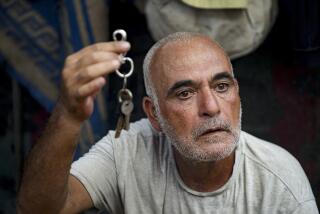CHILDREN OF BETHANY : The Story of a Palestinian Family<i> by Said K. Aburish (Indiana University Press: $18.95; 243 pp.)</i>
- Share via
In “Children of Bethany,” journalist Said K. Aburish presents a moving history of a Palestinian family--his own--”unfortunate enough to experience most of the dislocating events which began in Palestine and the Arab world in 1917.” His stated intention is to avoid making accusations, which he manages through an admirable honesty, faithfully recounting details that make the history of his village come alive. It couldn’t have been easy to ask his own family some of the journalistic questions he clearly did in the course of his research, and he describes the moment when he reluctantly admitted to himself that he had to choose sides in the conflict. The picture that emerges is one of village life disrupted, of family scattered to the winds, of age-old traditions lost in a few generations. This intimate history is worth far more than yet another account of the complaints of warring factions.
The story begins in 1917 when the author’s grandfather, Khalil Aburish, returned from war in the uniform of sergeant in the Turkish army. Khalil was village leader simply because he had, by force of imagination, managed to become the richest man. He had discovered a way to exploit the tourist attraction of the area: Bethany, in the shadow of Jerusalem, contained the tomb of Lazarus, and his family held rights to the spot. As it grew wealthy, the family distinguished itself from other villagers with a modern dwelling (not a cave such as other villagers inhabited), sophisticated food (fish was unknown and therefore suspect) and clothing (Khalil was first in the village to wear “much-whispered-about underpants”).
The new British rule made little immediate difference to Bethany, a poor agricultural community as dependent on rain as it had been in Biblical times. The colonial government was happy to leave Khalil in place as village leader. The British, however, introduced wage jobs, bringing wealth but forever altering the independence of subsistence-level life. The 1930s saw a rise in Palestinians’ consciousness of national over village identity. Here again, personal stories are much more telling than a raft of statistics. A young villager travels for the first time through his land and sees the similarities and differences among his people, to whom the English are trying to apply a single policy. As the conflict grew in the 1940s, Aburish also shows how Palestine became a focus of international concern much more quickly than Palestinians became aware of international issues.
The later history is much more familiar to readers: the establishment of Israel, escalation of hostilities, emigrations, life in refugee camps, the impossibility of the simplest friendly gestures between Arab and Jew. One painful memory the author uses to underline the fragmentation of the Palestinian point of view is a meeting with his brother just after the Munich massacre of 11 Israeli Olympic athletes. Is your group responsible?, the author wants to know of a brother he hasn’t seen in several years. “Remember, you live in a fancy apartment,” his brother answers. “The people who did this probably come from refugee camps. They can’t afford to behave like gentlemen.”
But the underlying sadness of the book is expressed by the author’s father: “We . . . my generation, are safe because while in some ways we belong to two worlds, we are more a part of the old than the new--there was no loss of identity. You are international nomads; you belong to where the grass is greener, regardless of family and roots. Soon the only thing you will have in common is your name.”
More to Read
Sign up for Essential California
The most important California stories and recommendations in your inbox every morning.
You may occasionally receive promotional content from the Los Angeles Times.













